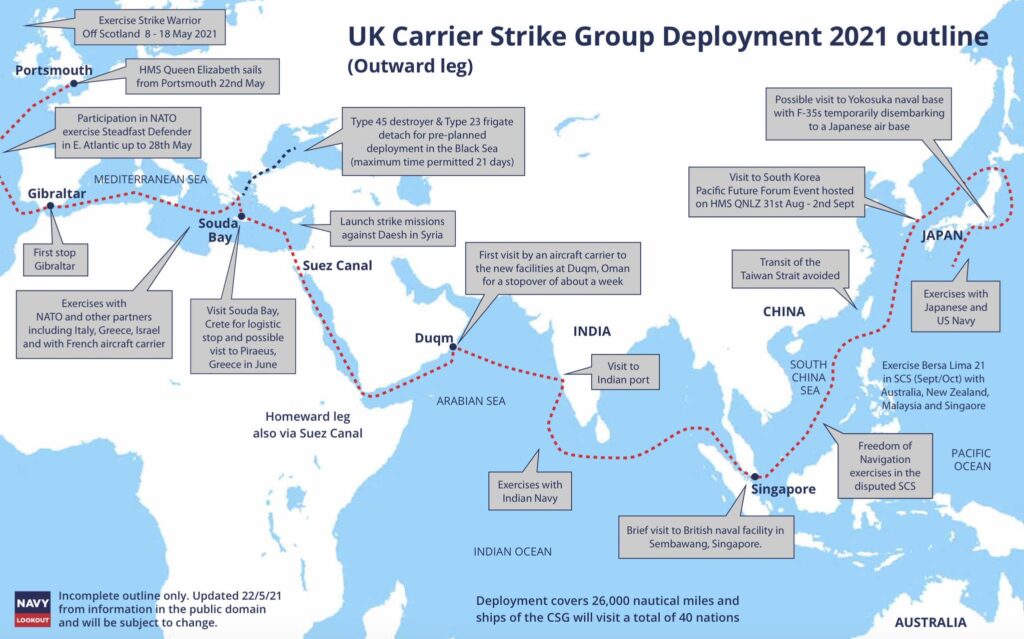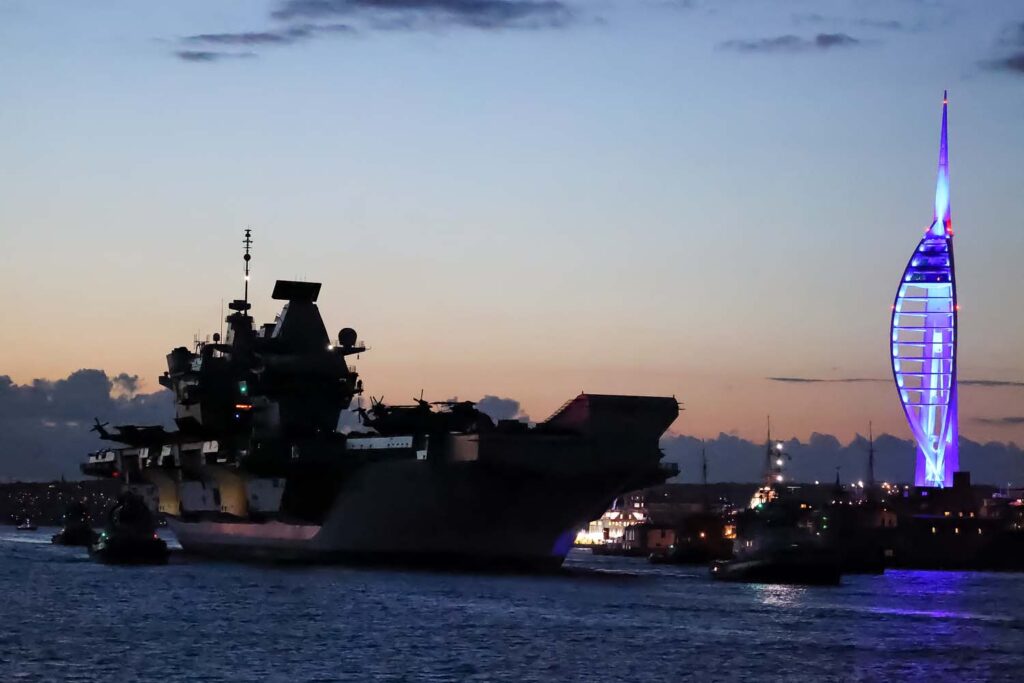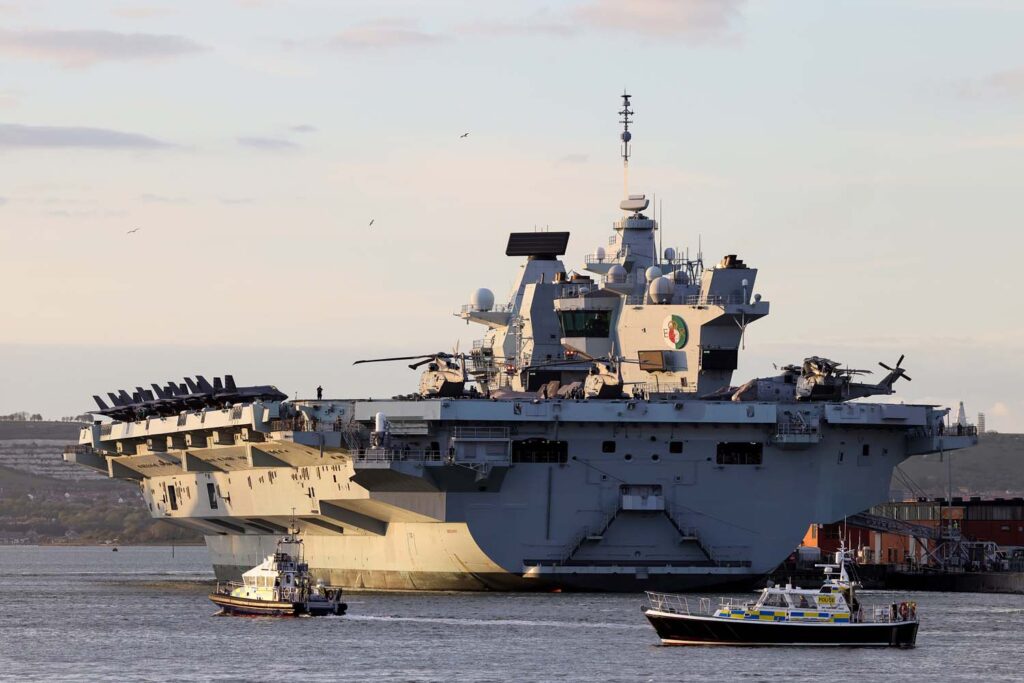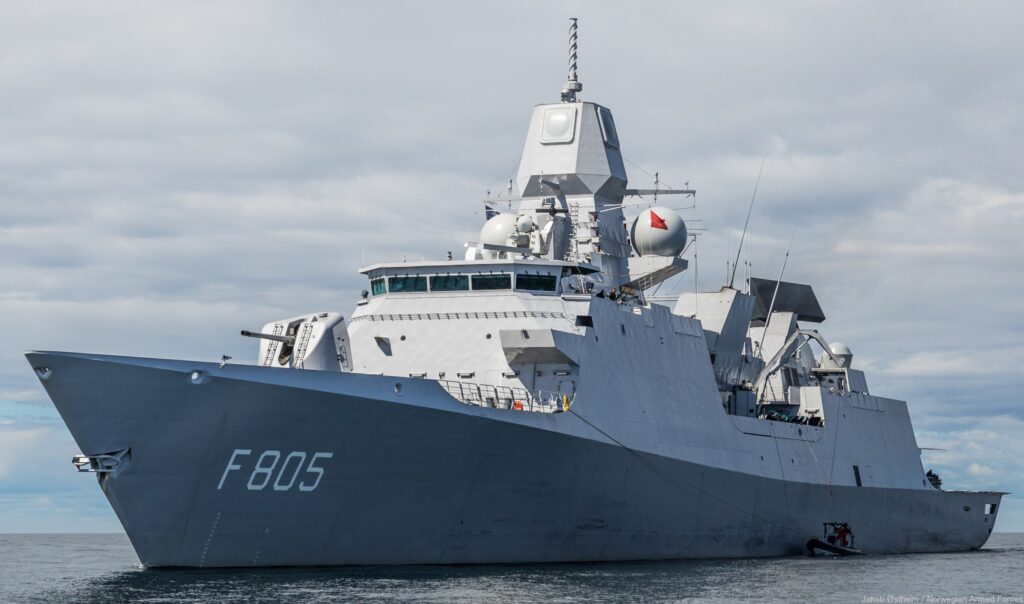Britain’s new flagship aircraft carrier will lead the largest concentration of maritime and air power to be deployed from the UK in a generation.
The Royal Navy’s flagship, HMS Queen Elizabeth, is busy with the preparations of a long deployment. UK Ministry of Defence announced several details about the mission.
The press release issued by the UK MoD as follows;
Nine ships, 32 aircraft, and 3,700 personnel will set sail today on the UK Carrier Strike Group’s maiden operational deployment.
The seven-month global deployment will extend through the Mediterranean and Indian Ocean and on to the Indo-Pacific, interacting with more than one fifth of the world’s nations.
Britain’s new flagship aircraft carrier, HMS Queen Elizabeth, will lead six Royal Navy ships, a Royal Navy submarine, a US Navy destroyer and a frigate from the Netherlands in the largest concentration of maritime and air power to leave the UK in a generation.
Her Majesty the Queen visited her namesake vessel – which she commissioned in 2017 – this morning before the aircraft carrier sets sail from Portsmouth, meeting crew members and wishing them luck in what will be an unforgettable life experience by being part of naval history.

Prime Minister Boris Johnson was also among those to visit HMS Queen Elizabeth ahead of her departure, joined on Friday by Defence Secretary Ben Wallace, First Sea Lord, Admiral Tony Radakin and Chief of the Air Staff, Air Chief Marshal Sir Mike Wigston on the flight deck.
Defence Secretary Ben Wallace said:
“The UK’s Carrier Strike Group sets sail to write Britain’s name in the next chapter of history – a truly global Britain that steps forward to tackle the challenges of tomorrow, working hand-in-hand with our friends to defend our shared values and uphold the rules-based international order. This deployment shows that we are strong on our own but even stronger with our allies. I want to join the nation in wishing the crews across the Carrier Strike Group every success as they depart on this truly historic endeavour.“
In a projection of the UK’s global reach and influence, the Carrier Strike Group will interact with over 40 nations during its 26,000-nautical-mile global tour, undertaking over 70 engagements, exercises and operations with allies and partners.
As outlined in the recently-published Defence Command Paper, the Carrier Strike Group is a demonstration of the UK’s commitment to be ready to confront future threats alongside international partners and help seize new opportunities for Global Britain.

Underscoring the UK’s leading role in NATO, in the coming days the Carrier Strike Group will take part in NATO’s Exercise Steadfast Defender. The HMS Queen Elizabeth Strike Group will also provide support to the Alliance’s Operation Sea Guardian and to maritime security operations in the Black Sea during the deployment.
Working alongside another key NATO ally, the Carrier Strike Group will be joined by French Aircraft Carrier Charles De Gaulle for a period of dual carrier operations in the Mediterranean.
In the Indo-Pacific, the Carrier Strike Group will visit India, Japan, the Republic of Korea and Singapore to strengthen Britain’s security relationships, reinforce political ties and support our UK exports and international trade agenda.
Elements of the Carrier Strike Group will also participate in Exercise Bersama Lima to mark the 50th anniversary of the Five Powers Defence Arrangements between Malaysia, Singapore, Australia, New Zealand and the UK.

The next chapter in UK Carrier Strike capability
The deployment is primarily centred on regenerating the UK’s Carrier Strike capability – a decade-long journey which is now entering its next chapter.
It comes after the Prime Minister announced in November an increase in Defence funding of over £24 billion across the next four years, enabling our Armed Forces to adapt to meet future threats. The Strike Group’s cutting-edge platforms are expertly operated by 3,700 personnel from the UK, US and Netherlands armed forces including a company of Royal Marines Commandos.
HMS Queen Elizabeth is the largest and most powerful surface vessel in the Royal Navy’s history. In a true success story for British industry she was built by a cast of more than 10,000, including more than 800 apprentices, in six dockyards from the banks of the Clyde to the River Torridge quaysides.
Joining her are a surface fleet of Type 45 destroyers, HMS Defender and HMS Diamond, Type 23 anti-submarine frigates HMS Kent and HMS Richmond, and the Royal Fleet Auxiliary’s RFA Fort Victoria and RFA Tidespring.
US Navy destroyer USS The Sullivans and the Royal Netherlands Navy’s frigate HNLMS Evertsen will be fully integrated for the duration of the deployment.

On the HMS Queen Elizabeth‘s flight deck are eighteen state-of-the-art F-35B fast jets, operated by joint RAF and Royal Navy 617 squadron, and the US Marine Corps – the greatest quantity of fifth-generation Lightning jets ever put to sea. Operating alongside the jets are four Wildcat maritime attack helicopters, seven Merlin Mk2 anti-submarine helicopters and three Merlin Mk4 commando helicopters – the largest number of helicopters assigned to a single UK Task Group in a decade.
Commodore Steve Moorhouse, Commander HMS Queen Elizabeth Carrier Strike Group, said:
“As the Carrier Strike Group heads to sea, a new phase opens in Britain’s maritime renaissance. A year’s worth of exercises, and more than a decade of preparation, is over. HMS Queen Elizabeth, her escorts and her aircraft, will now begin the most important peacetime deployment in a generation.
It is the privilege of my career to lead 3,700 sailors, aviators and marines from the United Kingdom, United States and the Netherlands for the next seven-and-a-half months. On their behalf, I would like to thank all those in government, the armed forces and industry who have worked so hard to get us to the start line, and will continue to support us when we are away. Most importantly, I would like to thank our families. I have every confidence that these young men and women will do you proud.“
Naval Post Comment: The ongoing tension and arm-race between the U.S. Pacific is currently the most sensitive region of the world. Thus, the U.S. Navy deploys at the South China Sea with its allies to show presence and deterrence. In addition, the French carrier strike group completed its deployment named “Clemenceau 2021” in the region, conducted coordinated operations with the U.S. units. A few weeks later, the Royal Navy’s HMS Queen Elizabeth CSG set to sail for deployment in similar areas. In addition to the deployment areas, both CSGs contain not only U.S. but also other European countries’ assets in the force composition. This is a strong clue that France and the U.K. plan to show their presence in coordination with the U.S. because the ties between the European countries and the U.S. became stronger after Joe Biden won the Presidential election in the U.S.
Check out Naval Library App to find out the specifications of HMS Queen Elizabeth and CSG assets.





